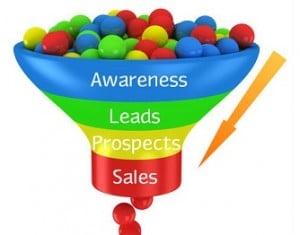You’ve probably heard it before: every solid marketing strategy begins with goals and objectives.
While that’s certainly true, you may not know what those targets should look like if you’re dabbling in a content marketing tactic like webinars for the first time. In this post, we dig a little deeper into the process of setting realistic goals and objectives for a webinar, as well as provide insight into practical things you should look at when planning for success.
Evaluating Higher-Level Business Goals
You can’t possibly formulate an effective execution strategy for webinar marketing before identifying the high-level business goals this tactic can help you achieve. Therefore, you need to start this process by mapping out your overall goals for growth and then figuring out how webinars can potentially fit in to your plan. This includes pinpointing the stages of the sales funnel at which you’ll leverage a webinar to achieve a specific goal.
For example, if your business goal is to increase revenue by 20% for the year, you’ll need to improve sales conversion rates. To do that, you can use webinars in one of several ways:
- generate awareness
- draw in qualified leads
- move prospects up the interest ladder
How many webinars you create and when you’ll use them depends on your product or service offering, how you structure your sales funnel, and what you hope to achieve through this communication tool.
Formulating Webinar Goals and Objectives with a Specific and Narrow Focus
It’s all too easy to say, “Our goal is to build a reputation as a thought leader in XYZ.” Yes, it’s a goal, but it’s not one that’s very focused, specific, or effective. If we give this a little more substance, the goal and objective might look something like this:
Goal: Build thought leadership by educating prospects and customers on XYZ using relevant, unique, and expert insights that are appropriate for their level of education.
Objective: Achieve a 35% response rate and 80% satisfaction rate as measured by an exit survey.
At this point, you might be wondering what other kinds of goals you can set for each webinar. While we won’t go into metrics or the intelligence you can potentially gather in this post, you should consider the following areas:
- Target registration goals
- Target attendance goals
- Real-time feedback goals
- Audience retention goals
- Thought leadership goals
- Post-event goals
- Sales-specific goals
When you break down each of these areas, you can start to create sub-goals and objectives. Let’s take target registration goals as an example. It all starts with a landing page, which means you’ll not only define your goal for the number of registrations you hope to receive, but you’ll also ask key questions like “What are my traffic goals?” and “What are my CTR goals?” These answers are crucial because when you compare them to your actual results, you’ll find they indicate the quality of your message and the effectiveness of your landing page. As you can see, you suddenly have a subset of goals you need to define as part of your webinar strategy.
Action Steps:
-
List your overall business goals.
-
Identify which goals you can work toward through your webinar marketing efforts.
-
Outline how you’ll use webinars as part of your sales process.
- Formulate goals for each webinar.
-
Formulate objectives for each of those goals.
Although you probably don’t need the reminder, you’re getting it anyway: goals must be SMART (specific, measurable, achievable, realistic, and time-based). If you can’t establish a specific metric that can be measured to determine your success, then you need to rethink your goal and its supporting objective because you cannot manage what you cannot measure.
Do you struggle to set goals and objectives for your webinars? Perhaps you find it a challenge with any strategy you develop. You might even be the polar opposite and this part of the process doesn’t really faze you. We’d love to hear from you either way, so let us know if you have any questions, comments, or advice for others by dropping us a line in the comment box below.
Shawn Manaher is the founder and CEO of The Content Authority. He’s one part content manager, one part writing ninja organizer, and two parts leader of top content creators. You don’t even want to know what he calls pancakes.


